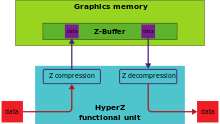HyperZ
HyperZ is the brand for a set of processing techniques developed by ATI Technologies and later Advanced Micro Devices and implemented in their Radeon-GPUs. HyperZ was announced in November 2000[1] and was still available in the TeraScale-based Radeon HD 2000 Series[2][3] and in current Graphics Core Next-based graphics products.[4]

On the Radeon R100-based cores, Radeon DDR through 7500, where HyperZ debuted, ATI claimed a 20% improvement in overall rendering efficiency. They stated that with HyperZ, Radeon could be said to offer 1.5 gigatexels per second fillrate performance instead of the card's apparent theoretical rate of 1.2 gigatexels. In testing it was shown that HyperZ did indeed offer a tangible performance improvement that allowed the less endowed Radeon to keep up with the less efficient GeForce 2 GTS.[5]
Functionality
HyperZ consists of three mechanisms:
- Z compression
- The Z-buffer is stored in a lossless compressed format to minimize the Z-Buffer bandwidth as Z read or writes are taking place. The compression scheme ATI used on Radeon 8500 operated 20% more effectively than on the original Radeon 256.
- Fast Z clear
- Rather than writing zeros throughout the entire Z-buffer, and thus using the bandwidth of another Z-Buffer write, a Fast Z Clear technique is used that can tag entire blocks of the Z-Buffer as cleared, such that only each of these blocks need be tagged as cleared. On Radeon 8500, ATI claimed that this process could clear the Z-Buffer up to approximately 64 times faster than that of a card without fast Z clear.
- Hierarchical Z-buffer
- This feature allows for the pixel being rendered to be checked against the z-buffer before the pixel actually arrives in the rendering pipelines. This allows useless pixels to be thrown out early (early Z reject), before the Radeon has to render them.
Versions of HyperZ
With each new microarchitecture, ATI has revised and improved the technology.
- HyperZ – R100
- HyperZ II – R200 (8500-9250)
- HyperZ III – R300 in Radeon 9700[6]
- HyperZ III+ – R350 used in Radeon 9800, Radeon 9800 XL, Radeon 9800 Pro and Radeon 9800 SE
- HyperZ HD – R420 used in Radeon X700 to Radeon X850 XT PE
References
- "ATI HyperZ on 180nm Radeons" (pdf). 2000-11-03. Retrieved 2014-07-09.
- "Depth In-depth" (pdf). 2012-10-10.
- "Radeon Gallium3D Hierarchical-Z Updated (R600)". Radeon Gallium3D Hierarchical-Z Updated (R600). 2012-02-08.
- "Feature matrix of the free and open-source "Radeon" graphics device driver". Retrieved 2014-07-09.
- Witheiler, Matthew (2000-07-17). "AnandTech: ATI Radeon 64MB DDR". Retrieved 2014-07-24.
- "ATi takes over 3D technology Leadership with Radeon 9700 and HyperZ III". Tom's Hardware. 2002-07-18. Retrieved 2014-07-09.